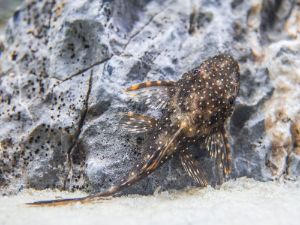
Rio Ucayali Bristlenose Pleco is a member of the Loricariidae family of South American suckermouth catfishes.While many suckermouth catfish species have yet to be bred commercially in aquariums, the very rare Orange Spot Bristlenose Pleco is now available

The Ancistrus dolichopterus is a type of suckermouth catfish native to South America. It is also known as the Rio Ucayali Bristlenose Pleco. The extremely rare Orange Spot Bristlenose Pleco is now for sale as a tank-bred specimen for the first time in history. This pleco, in contrast to other species of Ancistrus, is entirely marked in orange and cream. It differs from other species of Ancistrus by the development of several bristle-like appendages on the face region when it is a juvenile. The males tend to grow longer and more robust appendages than the females.
Since it is a peaceful and hardy species, the Orange Spot Bristlenose Pleco is great for most aquariums. While common plecos like the Hypostomus plecostomus and the Trinidad pleco can reach heights of 18 to 20 inches (45 to 51 centimeters), the Bristlenose pleco tops out at just 4 to 5 inches (10 to 13 centimeters) (10 to 13 cm). Because of their small size, plecos can thrive in aquariums as small as 30 to 40 gallons with proper care. Although male plecos are notoriously territorial, most fights can be avoided by simply giving the fish plenty of room to swim and hiding places. Usually the Orange Spot Bristlenose Pleco won't bother with its tank mates, but it is possible for the Pleco to eat small shrimp fry. However, some commercial suppliers of dwarf shrimp also breed bristlenose blecos in the same facilities.
After getting used to its new environment, the Orange Spot Bristlenose Pleco will become more active during the day, when it can take advantage of its preferred hiding spots among the tank's rocks and driftwood. It is not as wood-hungry as other plecos (Panaque species, etc.). To be sure, it could use some more wood (or bio-film on driftwood). The Orange Spot Bristlenose Pleco, even when still a juvenile, can quickly clear out a tank full of algae. The Orange Spot Bristlenose Pleco's diet should consist primarily of vegetable matter, including high-quality vegetable flakes, sinking algae wafers, and pellets. It thrives on a varied diet that includes shelled peas, spinach, zucchini, and cucumber. Meaty treats, such as bloodworms, may be fine when provided sparingly. The fish and the aquarium environment could be harmed by a diet high in meat or animal protein.

References
Albino Bushy Nose Pleco (Ancistrus sp.) is a member of the Loricariidae family of South American suckermouth catfishesAsian Stone Mini Catfish (Hara jerdoni) Their small size makes them perfect for small tanks - they only grow to a maximum of 1 1/2 inches in length
Banjo Catfish (Bunocephalus coracoideus) this catfish is popular because of its strange appearance
Bristlenose Pleco (Ancistrus sp.) is a member of the Loricariidae family of South American suckermouth catfishes
Corydoras sterbai (Sterba's Corydoras) are among the most popular of the numerous currently known species within the Corydora classification
L134 Leopard Frog the Imperial Tiger Pleco (Peckoltia compta) is a member of the Loricariidae family of South American suckermouth
L201 Snowball Pleco (Hypancistrus inspector) also known as the Orinoco Angel Pleco, is a member of the Loricariidae family of South American suckermouth catfishes
L333 King Tiger Pleco (Hypancistrus sp.) is primarily nocturnal, but will often become active during daytime hours once established in an aquarium with plenty of driftwood, rockwork
L340 Mega Clown AKA Imperial Tiger Pleco (Hypancistrus sp.)
Otocinclus Catfish known as Otto Cats, otos, or dwarf suckermouth catfish
Panda Cory Catfish (Corydoras panda) is a very animated, distinctively marked schooling fish that is perfect for the community and planted aquarium
Rio Ucayali Bristlenose Pleco is a member of the Loricariidae family of South American suckermouth catfishes. While many suckermouth catfish species have yet to be bred commercially in aquariums, the very rare Orange Spot Bristlenose Pleco is now available





